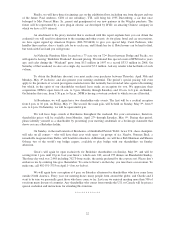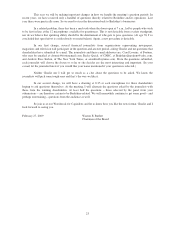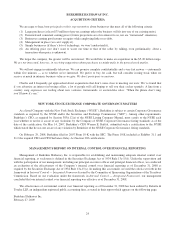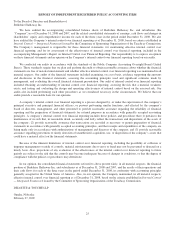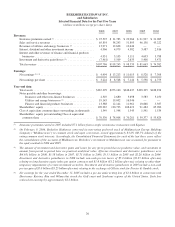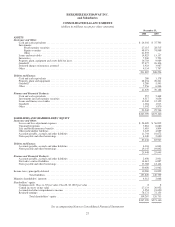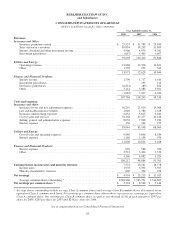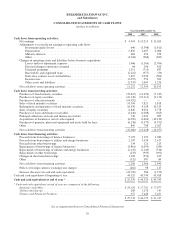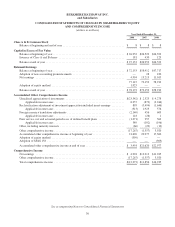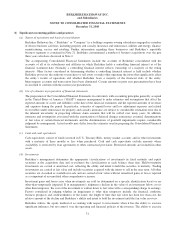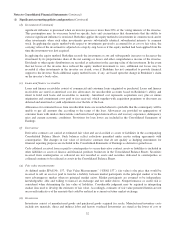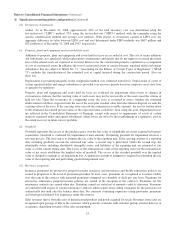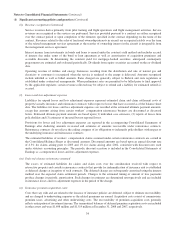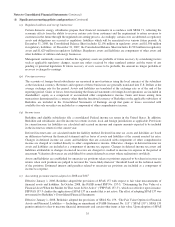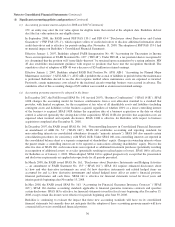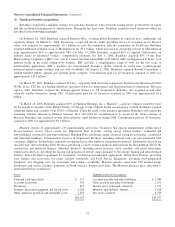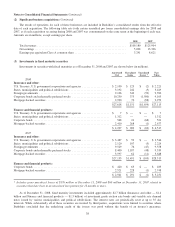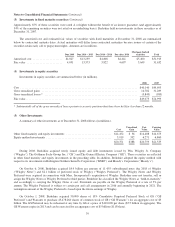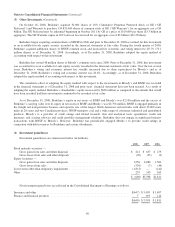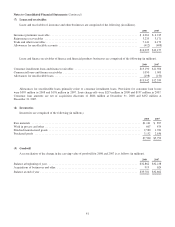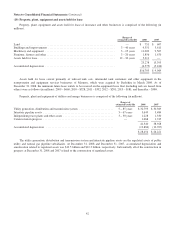Berkshire Hathaway 2008 Annual Report Download - page 34
Download and view the complete annual report
Please find page 34 of the 2008 Berkshire Hathaway annual report below. You can navigate through the pages in the report by either clicking on the pages listed below, or by using the keyword search tool below to find specific information within the annual report.Notes to Consolidated Financial Statements (Continued)
(1) Significant accounting policies and practices (Continued)
(d) Investments (Continued)
significant influence is presumed when an investor possesses more than 20% of the voting interests of the investee.
This presumption may be overcome based on specific facts and circumstances that demonstrate that the ability to
exercise significant influence is restricted. Berkshire applies the equity method to investments in common stock and to
other investments when such other investments possess substantially identical subordinated interests to common
stock. In applying the equity method with respect to investments previously accounted for at cost or fair value, the
carrying value of the investment is adjusted on a step-by-step basis as if the equity method had been applied from the
time the investment was first acquired.
In applying the equity method, Berkshire records the investment at cost and subsequently increases or decreases the
investment by its proportionate share of the net earnings or losses and other comprehensive income of the investee.
Dividends or other equity distributions are recorded as reductions in the carrying value of the investment. In the event
that net losses of the investee have reduced the equity method investment to zero, additional net losses may be
recorded if other investments in the investee are at-risk, even if Berkshire has not committed to provide financial
support to the investee. Such additional equity method losses, if any, are based upon the change in Berkshire’s claim
on the investee’s book value.
(e) Loans and finance receivables
Loans and finance receivables consist of commercial and consumer loans originated or purchased. Loans and finance
receivables are stated at amortized cost less allowances for uncollectible accounts based on Berkshire’s ability and
intent to hold such loans and receivables to maturity. Amortized cost represents acquisition cost, plus or minus
origination and commitment costs paid or fees received, which together with acquisition premiums or discounts are
deferred and amortized as yield adjustments over the life of the loan.
Allowances for estimated losses from uncollectible loans are recorded when it is probable that the counterparty will be
unable to pay all amounts due according to the terms of the loan. Allowances are provided on aggregations of
consumer loans with similar characteristics and terms based upon historical loss and recovery experience, delinquency
rates and current economic conditions. Provisions for loan losses are included in the Consolidated Statements of
Earnings.
(f) Derivatives
Derivative contracts are carried at estimated fair value and are classified as assets or liabilities in the accompanying
Consolidated Balance Sheets. Such balances reflect reductions permitted under master netting agreements with
counterparties. The changes in fair value of derivative contracts that do not qualify as hedging instruments for
financial reporting purposes are included in the Consolidated Statements of Earnings as derivative gains/losses.
Cash collateral received from or paid to counterparties to secure derivative contract assets or liabilities is included in
other liabilities or assets of finance and financial products businesses in the Consolidated Balance Sheets. Securities
received from counterparties as collateral are not recorded as assets and securities delivered to counterparties as
collateral continue to be reflected as assets in the Consolidated Balance Sheets.
(g) Fair value measurements
As defined under SFAS No. 157, “Fair Value Measurements” (“SFAS 157”), fair value is the price that would be
received to sell an asset or paid to transfer a liability between market participants in the principal market or in the
most advantageous market when no principal market exists. Market participants are assumed to be independent,
knowledgeable, able and willing to transact an exchange and not under duress. Nonperformance or credit risk is
considered when determining the fair value of liabilities. Considerable judgment may be required in interpreting
market data used to develop the estimates of fair value. Accordingly, estimates of fair value presented herein are not
necessarily indicative of the amounts that could be realized in a current or future market exchange.
(h) Inventories
Inventories consist of manufactured goods and purchased goods acquired for resale. Manufactured inventory costs
include raw materials, direct and indirect labor and factory overhead. Inventories are stated at the lower of cost or
32


